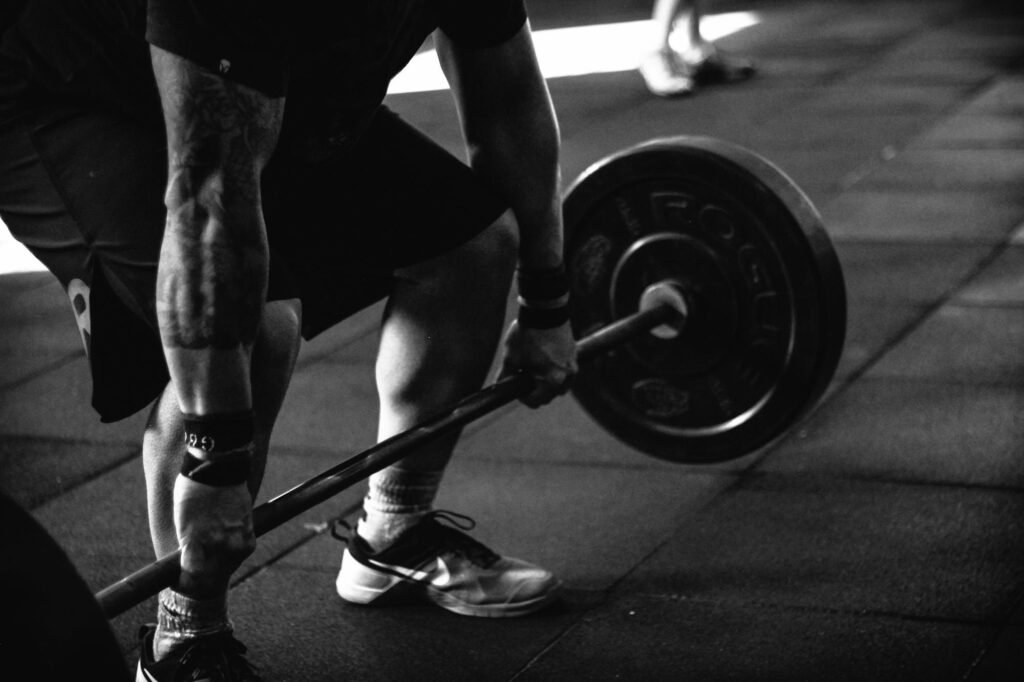Introduction to Anaerobic Exercise
Anaerobic exercise is a dynamic type of physical activity defined by brief but strong bursts of effort that frequently occur without the use of oxygen for energy generation. Anaerobic exercise, as opposed to aerobic exercise, which requires a constant oxygen supply to support extended activity, uses the body’s fast-twitch muscle fibers and mostly draws on stored energy sources such as glycogen. This high-intensity method causes quick energy release, promoting explosive motions and muscular contractions that test the body’s boundaries. Anaerobic exercises are well-known for their capacity to rapidly increase strength, power, and speed, making them popular among athletes and fitness enthusiasts seeking to optimize performance in brief bursts of activity.
In the world of anaerobic exercise, the absence of oxygen as the principal energy source drives people into a state of high exertion and fast energy consumption. This anaerobic route emphasizes urgent energy demands, pushing athletes and exercisers to their limits in brief bursts of activity. Anaerobic training stimulates muscular development, increases power production, and improves overall athletic performance because it targets fast-twitch muscle fibers. While aerobic exercise stresses endurance and cardiovascular health, anaerobic exercise focuses on explosive strength and speed, making it an important part of well-rounded fitness regimens and sports training programs.
Benefits of Anaerobic Exercise
Increased Strength
One of the key advantages of anaerobic training is its capacity to greatly improve muscular strength. Weightlifting and resistance exercise promote muscular growth by exposing muscles to resistance, resulting in hypertrophy (muscle growth) over time. This increased strength not only makes daily chores simpler, but it also lowers the chance of injury since stronger muscles offer more support and stability to joints and bones.

Enhanced Stamina
While aerobic exercise is frequently recognized for its capacity to enhance cardiovascular endurance, anaerobic exercise should also be considered when it comes to increasing stamina. High-intensity sports such as sprinting, leaping, and interval training can test your body’s boundaries, boosting your ability to perform brief bursts of strong effort over time. This can translate into increased overall stamina and endurance, allowing you to engage in high-intensity physical exercise for longer periods.
Improved Metabolic Health
Anaerobic exercise helps to improve metabolic health by increasing insulin sensitivity and glucose metabolism. High-intensity activities, such as HIIT, have been demonstrated to improve the body’s capacity to use glucose efficiently, lowering the risk of insulin resistance and type 2 diabetes. Anaerobic exercise also stimulates fat loss and boosts resting metabolic rate, which contributes to a healthy body composition and lowers the risk of obesity-related disorders.
Increased Bone Density
Weight-bearing anaerobic workouts, such as weightlifting and resistance training, are known to promote bone remodeling and density. These exercises cause mechanical stress on bones, which promotes mineral deposition such as calcium and phosphorus, making bones stronger and less prone to fractures and osteoporosis. Regular anaerobic exercise can assist preserve bone health and lower the risk of age-related bone loss.
Enhanced Mood and Mental Well-being
Aside from physical advantages, anaerobic exercise has a significant influence on mental health and well-being. High-intensity exercises cause the production of endorphins and other neurotransmitters in the brain, resulting in feelings of pleasure and lowering tension, anxiety, and sadness. Regular exercise has also been related to better cognitive function and memory, which improves general brain health and cognitive performance.
Improved Cardiovascular Fitness
Anaerobic exercise typically targets the anaerobic energy system, although it can also improve cardiovascular fitness. Interval training and circuit training raise heart rate and improve blood flow to muscles, increasing cardiovascular efficiency and retraining the heart and lungs to supply oxygen more efficiently during strenuous exercise. This combined advantage of anaerobic exercise improves cardiovascular health and lowers the risk of heart disease.
Enhanced Athletic Performance
Anaerobic training is critical for athletes and anybody trying to improve their athletic performance in sports and other physical pursuits. Sprinting, leaping, and agility workouts help athletes improve their speed, power, and agility, allowing them to thrive at their sport. Athletes that incorporate anaerobic training into their program can develop the explosive strength and dynamic movement patterns required for success in competitive sports.
Increased EPOC (Excess Post-Exercise Oxygen Consumption)
Anaerobic exercise has been linked to a condition known as Excess Post-Exercise Oxygen Consumption (EPOC) or the “afterburn effect.” Following a high-intensity anaerobic workout, the body continues to burn calories at a rapid pace to replenish energy reserves, repair muscle tissue, and restore homeostasis. This extended calorie burn after exercise can help with weight loss and increase total metabolic rate over time.
Types of Anaerobic Exercise

Weightlifting: Building Strength and Endurance
Weightlifting, often known as strength or resistance training, is a key component of anaerobic exercise. Lifting weights targets particular muscle areas, promotes muscular development, and improves overall strength and endurance. Weightlifting, whether performed with free weights, weight machines, or bodyweight exercises such as push-ups and squats, is a versatile and efficient approach to add anaerobic activity into your fitness program. By repeatedly exercising your muscles with progressive stress, you may stimulate development and enhance anaerobic performance over time.
Sprinting: Maximizing Power and Speed
Sprinting is another effective kind of anaerobic training that emphasizes brief bursts of full effort. This Exercise on a track, up a hill, or on a treadmill is a high-intensity sport that activates fast-twitch muscle fibers and needs rapid power generation to drive your body forward. This develops not just speed and agility, but also anaerobic capacity, allowing you to push your boundaries and perform at your best. Sprint intervals in your training routine can help you gain endurance, burn calories, and improve your overall anaerobic fitness.
High-Intensity Interval Training (HIIT): Efficiency and Effectiveness
High-Intensity Interval Training (HIIT) is a popular and effective type of anaerobic training that alternates short bursts of intense activity with brief intervals of rest or active recovery. This versatile workout strategy is adaptable to a variety of activities, including cardio, weight training, and plyometrics, making it appropriate for people of all fitness levels. By alternating between moments of maximal exertion and recuperation, HIIT workouts increase calorie burn, enhance metabolism, and improve cardiovascular and muscular endurance. Including HIIT workouts in your weekly regimen will help you gain the advantages of anaerobic training while also improving time efficiency and workout effectiveness.

Plyometrics: Explosive Power and Coordination
Plyometric workouts, often known as jump training, are dynamic motions that emphasize explosive force and fast muscular contractions. Plyometric workouts include box jumps, jump squats, and burpees, all of which take maximum effort and coordination to do. Plyometrics are especially useful for enhancing anaerobic performance in sports requiring explosive movements, such as basketball, volleyball, and running. By include plyometric exercises in your workout routine, you may develop muscle power, agility, and anaerobic capacity, resulting in better athletic performance and functional fitness.
Circuit Training: Total-Body Conditioning
Circuit training is a versatile and effective type of anaerobic exercise in which you move through a succession of various exercises or stations with little break in between. This total-body workout strategy stimulates numerous muscle groups at once, giving a thorough aerobic and strength training stimulus. Circuit training may be tailored to specific goals, such as muscular endurance, fat reduction, or athletic performance, making it appropriate for those with a variety of fitness goals. Circuit training, which alternates between strength workouts, cardio intervals, and active recovery periods, improves anaerobic energy output, metabolic rate, and overall fitness and conditioning.
Resistance Band Workouts: Portable and Versatile
Resistance band exercises are a simple and effective method to include anaerobic training into your fitness program, whether you’re at home, in the gym, or on the road. These elastic bands provide variable resistance, allowing you to tailor the intensity of your exercises to your fitness level and goals. Resistance band workouts may target particular muscle areas or stimulate many muscles at once, making them ideal for strength training, toning, and rehabilitation. Incorporating resistance band workouts into your routine will help you build muscle strength, endurance, and stability while also providing the flexibility and convenience of portable training equipment.
Tips for Incorporating Anaerobic Exercise into Your Routine
Start Slowly
If you’re new to anaerobic training, you should start moderate and progressively raise the intensity of your exercises over time. This method helps to avoid damage and allows your body to adjust to the demands of high-intensity exercise.
Focus on Proper Form
Maintaining appropriate form is essential when performing anaerobic activities in order to enhance performance and reduce the chance of damage. Whether you’re lifting weights or sprinting, focus on technique and alignment to guarantee safe and effective movement.
Mix it Up
Variety is essential for a well-rounded training regimen. A variety of anaerobic workouts, along with aerobic activities and flexibility training, helps to reduce boredom, stimulate muscular growth, and increases overall fitness and agility.
The Role of Nutrition in Anaerobic Exercise
Importance of Protein Consumption
Protein is vital for anaerobic activity since it helps with muscle repair and development. Anaerobic exercises such as weightlifting and high-intensity interval training cause muscular stress and injury that must be addressed in order to increase strength and hypertrophy. Consuming a proper quantity of protein from lean meats, poultry, fish, eggs, dairy, and plant-based sources such as lentils and tofu is critical for providing the amino acids required for muscle recuperation and growth. Incorporating protein-rich meals into your diet before and after anaerobic exercises will help maximize muscle protein synthesis and improve the effectiveness of your training plan.
Carbohydrates for Fueling Performance
Carbohydrates are the major source of energy during anaerobic activity, providing the fuel required for high-intensity efforts and long-term performance. Consuming carbs before exercise helps refill glycogen reserves in the muscles and liver, guaranteeing optimal energy levels throughout anaerobic activity. Choose complex carbs such as whole grains, fruits, vegetables, and legumes, which give a consistent release of glucose and long-lasting energy without producing blood sugar spikes or crashes. By including carbs into your pre-workout meals and snacks, you may improve your anaerobic performance and maintain high energy levels during your workouts.
Importance of Hydration
Staying hydrated is critical for good performance and recovery during anaerobic activity. Dehydration can decrease physical performance, limit exercise capacity, and raise the risk of heat-related disorders such heat exhaustion and heatstroke. During high-intensity anaerobic exercises, the body loses fluids through perspiration, which can lead to dehydration if not properly supplied. To stay hydrated during exercises, drink water before, during, and after, and consider drinking electrolyte-rich beverages like sports drinks to restore lost minerals and keep fluid balance. Staying hydrated can help you maintain cardiovascular function, regulate body temperature, and improve the efficiency of your anaerobic training sessions.
Rest and Recovery Strategies for Anaerobic Exercise
Importance of Scheduled Rest Days
Rest and recuperation are critical components of any workout regimen, especially for those who engage in high-intensity anaerobic exercises. Anaerobic exercise promotes muscular growth and strength increases, but it also causes microscopic damage to muscle fibers, which takes time to heal and replace. Including specified rest days in your weekly calendar allows your muscles to properly recover from strenuous activities, lowering the risk of overtraining, injury, and burnout. Set aside at least one to two rest days each week to participate in low-intensity exercises or active recovery methods such as walking, stretching, or yoga to enhance circulation, flexibility, and muscular relaxation.
Prioritizing Quality Sleep
Quality sleep is vital for muscle recovery, hormone balance, and overall health and well-being, hence it is an important part of anaerobic exercise recovery. During sleep, the body goes through important physiological processes including as muscle repair, protein synthesis, and growth hormone release, all of which are necessary for optimal anaerobic performance and adaptability. Aim for 7-9 hours of undisturbed sleep each night, focusing on consistent sleep habits and providing a distraction-free sleep environment. Prioritizing excellent sleep can help you recover faster from anaerobic exercise, increase muscle growth, and improve physical and mental performance in following exercises.
Incorporating Active Recovery Techniques
In addition to regular rest days and adequate sleep, active recovery approaches can help to accelerate the recovery process and increase anaerobic exercise performance. Active recuperation is participating in low-intensity activities or moderate exercises that boost circulation, reduce muscular pain, and increase flexibility while generating no additional tiredness or stress on the body. Active rehabilitation treatments include walking, cycling, swimming, foam rolling, and yoga, all of which can help flush out metabolic byproducts, relieve muscular tension, and promote relaxation and healing. Incorporating active recovery into your post-workout regimen will help you recover faster, minimize muscular stiffness, and prepare your body for future anaerobic workouts.
Conclusion
Anaerobic exercise has several benefits for anyone looking to improve their strength, stamina, and general well-being. Incorporating exercises like weightlifting, sprinting, and HIIT into your daily routine can boost the advantages of anaerobic exercise by improving muscle tone, cardiovascular fitness, and metabolic health. Anaerobic workouts push the body’s fast-twitch muscle fibers, increasing muscular development and improving physical performance in a variety of activities. Furthermore, the high-intensity nature of anaerobic exercise increases the production of endorphins, which promote feelings of euphoria and mental clarity, resulting in a positive mentality and an enhanced overall mood.
Incorporating anaerobic training into your routine has far-reaching advantages for both your mental and emotional health. Anaerobic exercise, in addition to increasing physical strength and stamina, may be an effective stress reliever and relaxing technique. Anaerobic workouts’ focused intensity releases pent-up energy and tension, helping people to relax and decompress while also developing resilience and mental fortitude. Furthermore, the sense of achievement and pleasure gained from completing difficult anaerobic workouts may boost self-confidence and self-esteem, allowing people to face challenges and pursue their fitness objectives with renewed zeal and commitment.
Furthermore, the synergistic combination of anaerobic activity, right nutrition, rest, and recovery serves as the foundation for a balanced and long-term approach to fitness and wellbeing. Fueling your body with nutrient-dense meals that promote muscle repair and energy replenishment maximizes the advantages of anaerobic exercise, allowing you to perform at your best and recover more quickly between workouts. Prioritizing proper rest and recovery helps the body to adapt to the demands of anaerobic training, lowering the chance of injury and increasing long-term success. By incorporating anaerobic exercise into your daily routine, you may harness the transforming potential of high-intensity exercises to improve your physical, mental, and emotional well-being.
HAVE A GREAT DAY OR NIGHT!!!!!!!!!!!

